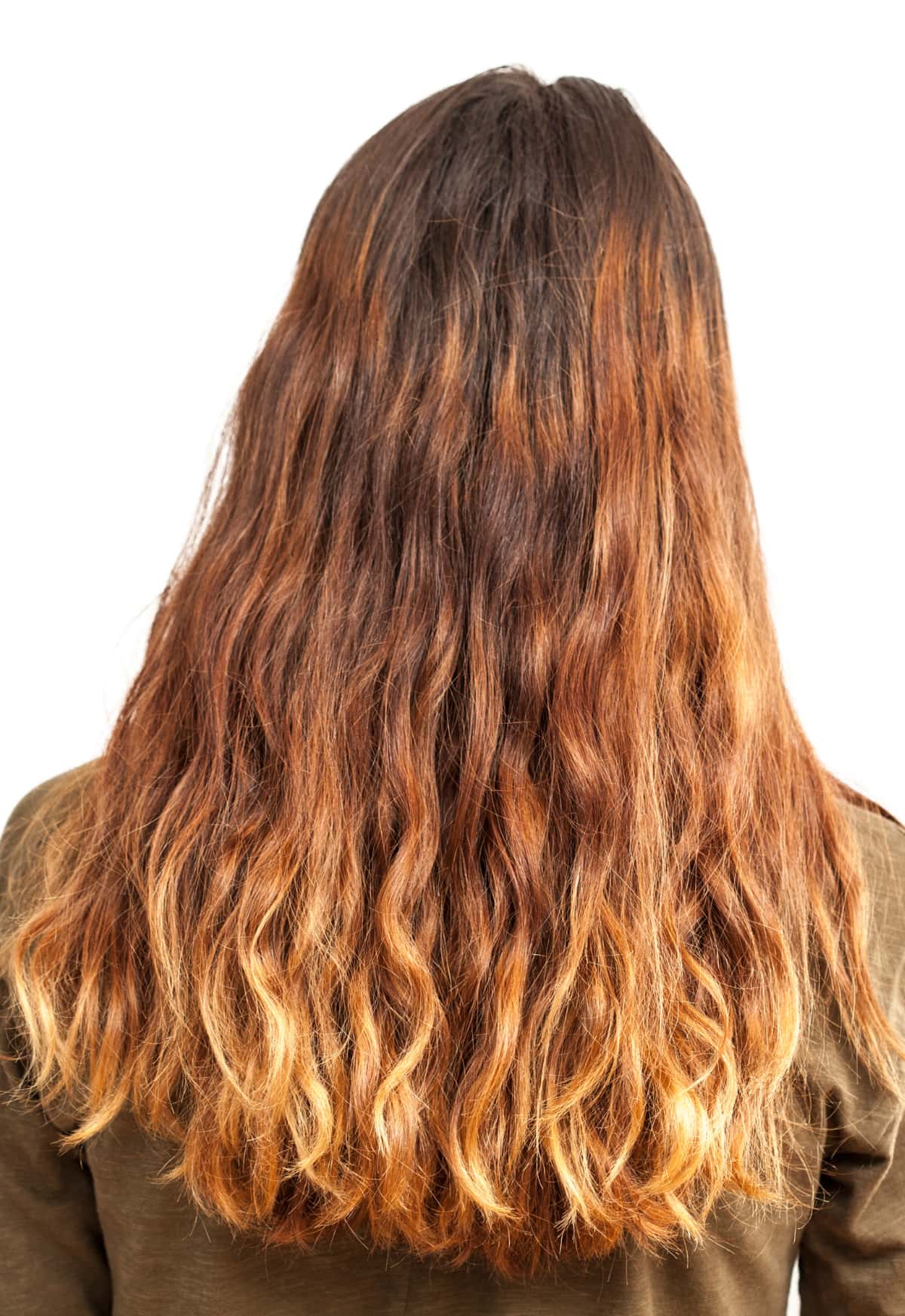
Wavy hair may seem low maintenance, but there’s still plenty of work that goes into keeping those locks looking fresh and fabulous all day long.
Like any hair type, wavy hair requires specific care and requirements. You may often wonder how to take care of your lovely mane. But don’t worry – we’ve got your back!
In this article, we’ll take a close look at some of the most effective techniques on how to take care of wavy hair. You’ll learn how to keep them hydrated, healthy, and always looking their absolute best.
We’ll also dive into the right products for wavy hair and how to avoid common problems. Because understanding how to look after your waves isn’t just about mastering a routine – it’s about embracing every part of your natural beauty.
Let’s embark on this adventure together!
Understanding Your Wavy Hair Type
Knowing the type of wavy hair that you have is the first step in taking good care of it. Once you know your type of wave, you can unlock your hair’s full potential.
Wavy hair falls into three primary categories: Type 2A, Type 2B, and Type 2C. Each category has its own distinct features and needs.
- Type 2A: This is fine, thin wavy hair that tends to be easy to manage. Your hair might fall somewhere between straight and wavy.
- Type 2B: This wave type has more body than 2A and shows more defined S-shaped waves. There could be some frizz at the crown of your head.
- Type 2C: This is thick, coarse wavy hair with well-defined waves or loose curls. It’s prone to frizz and often feels dry.
It’s important to note that having multiple wave types on one head is actually pretty common!
When identifying your wave pattern, take into account factors like strand thickness (fine, medium, or coarse), density (thin or thick), porosity (low or high), and elasticity, as these will all have an impactful role in how your hair reacts to products, styling techniques, and humidity levels.
The following table can help you figure out what type of wavy hair you have.
| Factors | Low | High |
| Thickness | Fine | Coarse |
| Density | Thin | Thick |
| Porosity | Low | High |
| Elasticity | Low | High |
Understanding what makes up your hair wave type allows you to make a more informed product selection and enables you to use better techniques for healthier strands over time.

How To Take Care Of Wavy Hair For Healthy Waves
Your wavy locks deserve nothing short of perfection. By following some key care practices every day, you can achieve healthy and vibrant waves.
Let’s explore essential techniques and tools for maintaining your waves at their finest.
Hydration is of utmost importance when it comes to caring for wavy hair. In order to minimize frizz and breakage, be sure to choose a shampoo and conditioner that’s designed to nourish these textures specifically.
- Shampoo: You’ll want to look for products without harsh sulfates, as these can strip the natural oils from your hair.
- Conditioner: Shop for conditioners made up of moisturizing ingredients like shea butter or argan oil. These ingredients will help replenish essential vitamins.
Now let’s talk about drying your waves. Traditional towels can cause friction that leads to frizz and damage.
For a gentle approach that won’t frizz out your locks after each wash, try to use either a microfiber towel or an old T-shirt to lightly blot dry your hair after washing.
Less is always more when styling wavy hair. Apply a small amount of a curl-enhancing product when damp and allow it to air dry naturally if possible – heat tools may disrupt your wave patterns over time.
Don’t underestimate the importance of regular trims! They play an essential part in maintaining healthy ends and preventing split ends that could spread further up the shaft causing damage if left untreated.
Most importantly, protect those waves while sleeping by using either a silk pillowcase or wrapping them with a satin scarf – both methods reduce friction on strands that could otherwise lead to frizzy knots and tangles.
The Best Products for Wavy Hair Maintenance
With the right products, you can maintain your wavy locks and keep them fresh and vibrant all day long.
The right shampoo is where it starts. Be sure to select a formula specifically created for wavy hair. These products contain ingredients designed to define and enhance waves.
Sulfates must also be avoided, as they strip your locks of natural oils that keep them looking their best.
After shampooing, you should use a conditioner that restores any lost moisture and leaves your waves feeling soft and manageable.
On top of using the right shampoo and conditioner, you’ll want to use a leave-in conditioner or serum for additional hydration and frizz control.
On days when your waves need an extra boost, try using a curl-enhancing mousse or cream. These products provide additional hold without making your locks feel stiff or crunchy.
Keep heat protection in mind if you plan on styling with curling irons or blow dryers regularly.
When shopping for products, remember:
| Type of Product | Why It’s Needed |
| Shampoo | Cleanses hair without stripping natural oils |
| Conditioner | Replenishes lost moisture |
| Leave-in conditioner/serum | Adds extra hydration; reduces frizz |
| Mousse/Cream | Provides hold; enhances curls |
| Heat protectant spray/gel | Shields from damage caused by heat styling tools |
It sounds like a lot of work but don’t give up. With patience, consistency, and the right products, you’ll see results that will turn heads.
Common Mistakes to Avoid with Wavy Hair
When caring for wavy hair, there are certain difficulties you need to be wary of. One common mistake is over-washing.
Excessive shampooing strips away natural oils found within your hair’s fiber, leaving the waves appearing dull and flattened.
Aim to wash wavy hair no more frequently than twice or three times each week for best results.
Over-brushing waves is another mistake many make when styling waves. Where straight hair may benefit from frequent brushing, overdoing it with waves can result in frizz and breakage.
To maintain healthy waves, it’s better to comb your hair out with your fingers or a wide-tooth comb only when necessary instead of brushing every day.
Try not to get stuck in the habit of overusing heat either. Continuous blow-drying, straightening, or curling with a curling iron may damage your delicate waves over time.
Whenever possible, try air-drying instead and use heat protection products when applying some form of heat to your hair.
Incorrect product selection could discourage your efforts. Choosing heavier products designed for curlier hair could weigh down and damage waves, while those crafted specifically for straighter strands might not provide sufficient hold or definition.
Most importantly, don’t neglect regular trims! Split ends aren’t only unsightly, they also impact healthy growth and how quickly curls recover after stretching.
Keep these common mistakes in mind when looking for the right products:
| Common Mistakes | Consequences |
| Over-washing | Dull & lifeless waves |
| Over-brushing | Frizz & breakage |
| Excessive heat usage | Damage over time |
| Wrong product choice | Weighed-down or undefined curls |
| Ignoring regular trims | Hindered healthy growth |
Please remember to always be kind to your beautiful natural waves. With proper care and consideration – and by avoiding common errors – your waves can flourish into stunning, eye-catching locks!

Wrapping Up: Sustaining the Health of Your Waves
Caring for your waves doesn’t need to be complicated. By using effective strategies and products, your lovely locks will stay beautiful and look their best.
Hydrate, hydrate, hydrate! Your hair needs water just like any part of the body does – drinking plenty of fluids will ensure that your locks remain moisturized from within, and make sure to use shampoos and conditioners designed specifically for wavy hair to get maximum hydration benefits.
Try not to use heat styling tools too often, as these can damage the natural structure of your waves and cause dryness or frizz. Always remember:
- Hydrate regularly
- Use a moisturizing shampoo and conditioner
- Avoid heat tools
On days when using curling irons or straighteners is unavoidable, don’t forget to use a heat protectant to help shield your strands against high temperatures that could damage them further.
Heat protectants form a shield between each strand of hair that helps guard it against potential harm from high-temperature styling tools.
Regular trims are absolutely crucial in order to preserve the health and appearance of wavy locks. By cutting away split ends every six to eight weeks, you will prevent further breakage and keep your waves looking their finest.
Keep in mind that each individual’s hair is unique. What works for one may not work for the next. Don’t hesitate to experiment with various techniques until you find one best suited for you and your hair type.
Finding a balance between levels can be achieved in many different ways – be it moisture, protein treatments, low-heat styles versus air-drying techniques, or different brands/products that might work better depending on your individual preferences/needs.
Your wavy locks deserve nothing less than love and care – let’s ensure they receive exactly what they need!
Frequently Asked Questions

Thank you for this post Audrey! What an education. I never knew a thing about porosity levels before and I didn’t consider the material of my pillow covers before. Great post, thank you for sharing!!!! xxx
Audrey put a lot of effort into this post and it shows! Very happy she wanted to help me out on this one 🙂
I love this post! My hair is slightly wavy on my top layers, and dead straight on the bottom layers. I can’t just leave it because half of it is wavy and cute and other half is weirdly straight (and flicks out at the ends!) so i always have to straighten it or curl it! I love the science behind the porosity of the hair! I never knew about this ‘hack’!
Great post babe!
Thank you so much! Happy you found this post useful ?
I have heard silk pillow covers are very healthy for hair! Also, I must test and see about my porosity level. It looks remarkably simple.
I agree! I want to try it myself too 🙂
Absolutely love the detail in Audrey’s post! I’m definitely going to try the porosity test.
Thank you for thinking of us curly haired ladies and including advice on your site 🙂
Georgia
I’m all for including everyone ❤️ I’m so happy you and Audrey both wanted to share tips and tricks!
Aw Audrey is so amazing! ❤️ Looking at this, I think I have 2B curls for sure! I need to treat them better lol